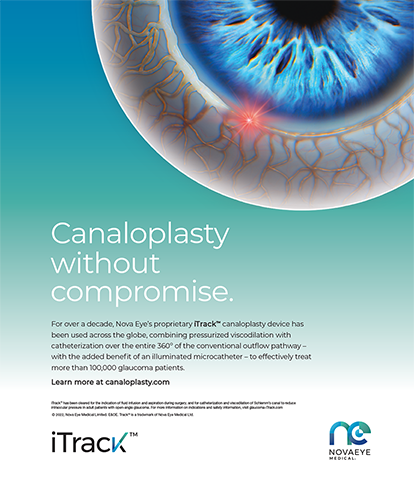Optimal keratoplasty (Opti-K; NTK Enterprises, Inc.) is a new form of laser keratoplasty performed with the Opti-K System (NTK Enterprises, Inc.) that reshapes the cornea to temporarily reduce symptoms of presbyopia and correct low to moderate hyperopia. Unlike conductive keratoplasty, this noninvasive form of laser thermal keratoplasty leaves the corneal epithelium and basement membrane intact. The treatment is indicated for patients 40 years of age and older who have a manifest refraction spherical equivalent of -0.25 to +3.00 D.
Opti-K and the device received CE Mark approval in Europe for two indications: the correction of low to moderate hyperopia and the improvement of near visual acuity in presbyopes. The procedure has also been used in the Bahamas to improve near visual acuity in postcataract surgery patients with monofocal IOLs and in post-LASIK patients. An investigational device exemption US clinical trial of the Opti-K System for the correction of low to moderate hyperopia is in progress.
HOW IT WORKS
Opti-K is an office-based laser vision correction procedure performed with a continuous-wave thulium fiber laser with a sapphire applanation window. The laser is housed in a compact case weighing 42 pounds. After the administration of a single drop of proparacaine, the cornea is applanated by an illuminated suction cone (Figure 1) with a sapphire window that has a crosshair reticle for centering over the pupil (Figure 2). Once suction has been applied, light from a thulium laser is delivered through sixteen optical fibers (Figure 3) and guided into the central cone of the suction ring, where the fibers are secured into position with magnets. The physician activates the laser, and 16 laser beams are irradiated onto the cornea in 2.5 seconds to produce a treatment pattern of 16 spots in two concentric circles (6 and 7.2 mm in diameter). At the conclusion of the procedure, a drop of bromfenac (Bromday; Bausch + Lomb) is applied. No antibiotics, bandage contact lens, or anesthetic drops are required. Patients have reported temporarily feeling a slight foreign body sensation after the treatment.
Figure 4 illustrates the central corneal steepening induced by the procedure. The corneal topographic change includes an eight-leaf rosette of alternating steeper and flatter sectors that produce corneal multifocality. Because the rosette extends from the center to the periphery of the cornea, multifocality is independent of pupillary size. Treatment does not abrade the cornea, because the sapphire window acts as a heat sink to protect the epithelium from thermal damage (Figures 5 and 6). Opacifications fade over time, and irradiated stromal tissue appears to return to its pretreatment condition.
CLINICAL FINDINGS
Adverse events such as a loss of distance BCVA, induced astigmatism, infection, recurrent erosion, and an increase in halos or glare have not been reported in the FDA clinical trial of 10 eyes with low to moderate hyperopia and presbyopia.1 Geometric mean improvements in uncorrected distance visual acuity were statistically significant (P < .05), ranging from a maximum of 4.6 ±1.7 lines 1 month postoperatively to 3 ±0.8 lines 9 months postoperatively. Geometric mean improvements in near visual acuity ranged from 4.1 ±2 lines 1 month postoperatively to 1.4 ±1.5 lines 9 months postoperativlely (P < .05 through the first 3 months). Improvement in uncorrected distance and uncorrected near visual acuity were 2.8 ±1.0 lines and 1.6 ±2.6 lines, respectively, 18 months postoperatively. Patients’ neuroadaptation to multifocality or blended vision produced by Opti-K occurred immediately after the treatment.
K. Jonathan Rodgers, FRCSC, DABO, a private practitioner in Nassau, the Bahamas, reported an improvement in binocular uncorrected near visual acuity in a small series of 22 emmetropic presbyopes (13 with 2 years of follow-up) treated bilaterally with Opti-K.2 All patients received secondary or tertiary treatments. Before the procedure, 9.1% had a binocular uncorrected near visual acuity of J2 (20/30; 0.67 decimal; 0.18 logMAR). Twelve and 24 months postoperatively, 91.7% (n = 11) and 69.2% (n = 9), respectively, had achieved this level of binocular near vision. Additionally, the patients’ distance vision improved or was maintained. With this treatment, distance visual acuity is maintained or improved in plano presbyopes and improved in hyperopic presbyopes.
CONCLUSION
Opti-K is a noninvasive, rapid, pain-free, office-based procedure that does not induce complications such as dry eye disease and ocular disturbances.1 The procedure appears to offer low to moderate hyperopes and presbyopes a temporary improvement in uncorrected near visual acuity while maintaining or improving their distance visual acuity.
Patients should be informed that the improvements in their distance and near vision will gradually diminish as they age and as the steepening and multifocality effects on the cornea regress. At that time, they can consider undergoing additional Opti-K treatment.
Michael Berry, PhD, is the director of research for NTK Enterprises, Inc. Dr. Berry may be reached at mberry@ntkok.com.
Harry Glen, MD, is on the medical staff at the Massachusetts Eye and Ear Infirmary in Boston and is a practitioner at Advanced Eye Centers in North Dartmouth, Massachusetts. He is a consultant to NTK Enterprises, Inc. Dr. Glen may be reached at 1lancer@bellsouth.net
James J. Salz, MD, is in private practice in Beverly Hills, California. He has received travel support from NTK Enterprises, Inc. Dr. Salz may be reached at (310) 444-1134; drjjsalz@gmail.com.
- Salz J, Glen HG, Berry M. Correction of low to moderate hyperopia by optimal keratoplasty: U.S. clinical trial. Paper presented at: ASCRS/ASOA Symposium & Congress; April 24, 2012; Chicago, IL.
- Rodgers KJ, Glen H, Berry M. Emmetropic presbyopia treatment: long-term near vision improvement by noninvasive keratoplasty. Paper presented at: XXIX ESCRS Congress; September 17-21, 2011; Vienna, Austria.


